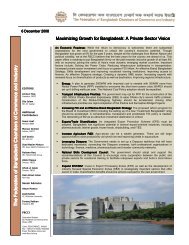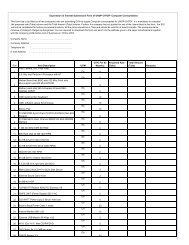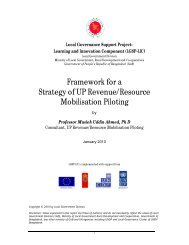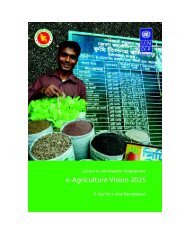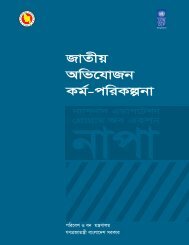The probable impacts of climate change on poverty - UNDP
The probable impacts of climate change on poverty - UNDP
The probable impacts of climate change on poverty - UNDP
You also want an ePaper? Increase the reach of your titles
YUMPU automatically turns print PDFs into web optimized ePapers that Google loves.
Goal 2: Achieve universal<br />
primary educati<strong>on</strong><br />
Goal 3: Promotegender<br />
equality and empower<br />
women<br />
Goals 4, 5 and 6: Health<br />
related issues<br />
Goal 7:<br />
Ensureenvir<strong>on</strong>mental<br />
sustainability<br />
Source: Modified from Reid H and Alam M, 2005<br />
1.2 Climate and Climate Change in Bangladesh<br />
<str<strong>on</strong>g>The</str<strong>on</strong>g> <str<strong>on</strong>g>climate</str<strong>on</strong>g> <str<strong>on</strong>g>of</str<strong>on</strong>g> Bangladesh is influenced by m<strong>on</strong>so<strong>on</strong> <str<strong>on</strong>g>climate</str<strong>on</strong>g> and characterized by high temperature, heavy<br />
rainfall, <str<strong>on</strong>g>of</str<strong>on</strong>g>ten-excessive humidity and marked seas<strong>on</strong>al variati<strong>on</strong>s. Although more than half the area is north <str<strong>on</strong>g>of</str<strong>on</strong>g> the<br />
Tropics, the effect <str<strong>on</strong>g>of</str<strong>on</strong>g> the Himalayan mountain chain is such as to make the <str<strong>on</strong>g>climate</str<strong>on</strong>g> more or less tropical throughout<br />
the year. <str<strong>on</strong>g>The</str<strong>on</strong>g> <str<strong>on</strong>g>climate</str<strong>on</strong>g> is c<strong>on</strong>trolled primarily by summer and winter winds, and partly by pre-m<strong>on</strong>so<strong>on</strong> (March to<br />
May) and post-m<strong>on</strong>so<strong>on</strong> (late October to November) circulati<strong>on</strong>. <str<strong>on</strong>g>The</str<strong>on</strong>g> Southwest M<strong>on</strong>so<strong>on</strong> originates over the<br />
Indian Ocean, and carries warm, moist and unstable air. <str<strong>on</strong>g>The</str<strong>on</strong>g> easterly Trade Winds are also warm, but relatively drier.<br />
<str<strong>on</strong>g>The</str<strong>on</strong>g> Northeast M<strong>on</strong>so<strong>on</strong> comes from the Siberian Desert, retaining most <str<strong>on</strong>g>of</str<strong>on</strong>g> its pristine cold, and blows over the<br />
country, usually in gusts, during dry winter m<strong>on</strong>ths.<br />
Bangladesh is already vulnerable to many <str<strong>on</strong>g>climate</str<strong>on</strong>g> <str<strong>on</strong>g>change</str<strong>on</strong>g> related extreme events and natural disasters. It is<br />
expected that <str<strong>on</strong>g>climate</str<strong>on</strong>g> <str<strong>on</strong>g>change</str<strong>on</strong>g> will bring <str<strong>on</strong>g>change</str<strong>on</strong>g>s in characteristics <str<strong>on</strong>g>of</str<strong>on</strong>g> natural hazards and gradual <str<strong>on</strong>g>change</str<strong>on</strong>g>s<br />
phenomen<strong>on</strong> <str<strong>on</strong>g>of</str<strong>on</strong>g> the physical system. Studies and assessments <str<strong>on</strong>g>of</str<strong>on</strong>g> <str<strong>on</strong>g>impacts</str<strong>on</strong>g>, vulnerabilities and adaptati<strong>on</strong> to <str<strong>on</strong>g>climate</str<strong>on</strong>g><br />
<str<strong>on</strong>g>change</str<strong>on</strong>g> and sea level rise for Bangladesh clearly dem<strong>on</strong>strates that Bangladesh is <strong>on</strong>e <str<strong>on</strong>g>of</str<strong>on</strong>g> the most <str<strong>on</strong>g>climate</str<strong>on</strong>g><br />
vulnerable countries in the world. <str<strong>on</strong>g>The</str<strong>on</strong>g> Fourth Assessment Report <str<strong>on</strong>g>of</str<strong>on</strong>g> the Intergovernmental Panel <strong>on</strong> Climate<br />
Change (IPCC), for South Asia, predicts that m<strong>on</strong>so<strong>on</strong> rainfall will increase, resulting in higher flows during<br />
m<strong>on</strong>so<strong>on</strong> seas<strong>on</strong> in the river system. It has also predicted that sea level rise will be between 0.18 to 0.79 meters<br />
which will lead to salinity intrusi<strong>on</strong> and coastal flooding. Rainfall is predicted to become higher and more erratic.<br />
Frequency and intensity <str<strong>on</strong>g>of</str<strong>on</strong>g> natural disasters are likely to increase especially in the northern and western part <str<strong>on</strong>g>of</str<strong>on</strong>g><br />
the country.<br />
4<br />
All <str<strong>on</strong>g>of</str<strong>on</strong>g> these together will <str<strong>on</strong>g>change</str<strong>on</strong>g> crop yields and affect many poor people’s livelihoods. For<br />
example, 2007 floods inundated 32,000 sq. km in area that destroyed over 85,000 houses and<br />
approximately 1.2 milli<strong>on</strong> acres <str<strong>on</strong>g>of</str<strong>on</strong>g> crops were destroyed or partially damaged. Total estimated<br />
loss in terms <str<strong>on</strong>g>of</str<strong>on</strong>g> dollar was over $1 billi<strong>on</strong>.<br />
It is likely that natural disasters will damage more houses and will cause temporary migrati<strong>on</strong>. It<br />
may also require children to help more with household works leaving less time for schooling.<br />
Malnourishment and diseases also impair learning. Extreme <str<strong>on</strong>g>climate</str<strong>on</strong>g> <str<strong>on</strong>g>change</str<strong>on</strong>g> related disasters<br />
threaten school buildings and educati<strong>on</strong>al materials. For example, cycl<strong>on</strong>e Sidr caused huge<br />
damage to school buildings and wiped out teaching materials.<br />
Adverse <str<strong>on</strong>g>impacts</str<strong>on</strong>g> <str<strong>on</strong>g>of</str<strong>on</strong>g> <str<strong>on</strong>g>climate</str<strong>on</strong>g> <str<strong>on</strong>g>change</str<strong>on</strong>g> are likely to reduce availability and deteriorate quality <str<strong>on</strong>g>of</str<strong>on</strong>g><br />
water for domestic use. Fetching water for domestic use, for which women are usually<br />
resp<strong>on</strong>sible are likely to bear disproporti<strong>on</strong>ate hardship when provisi<strong>on</strong> <str<strong>on</strong>g>of</str<strong>on</strong>g> these vital<br />
necessities becomes difficult.<br />
Direct <str<strong>on</strong>g>climate</str<strong>on</strong>g> <str<strong>on</strong>g>change</str<strong>on</strong>g> effects include increases in mortality and illness associated with heat waves,<br />
particularly am<strong>on</strong>gst the elderly and the urban poor. Women and children are particularly vulnerable<br />
to extreme weather events. For example, when the 1991 cycl<strong>on</strong>e hit Bangladesh, 90 percent <str<strong>on</strong>g>of</str<strong>on</strong>g> victims<br />
were women and children.<br />
Climate <str<strong>on</strong>g>change</str<strong>on</strong>g> is likely to increase the prevalence and infecti<strong>on</strong> <str<strong>on</strong>g>of</str<strong>on</strong>g> vector and water-borne diseases<br />
such as malaria and dengue fever, cholera and dysentery etc, Children and pregnant women are<br />
particularly susceptible to such diseases.<br />
Climate <str<strong>on</strong>g>change</str<strong>on</strong>g> will probably cause a decline in the quantity and quality <str<strong>on</strong>g>of</str<strong>on</strong>g> drinking water, which is a<br />
prerequisite for good health. Malnutriti<strong>on</strong>, main cause <str<strong>on</strong>g>of</str<strong>on</strong>g> ill health am<strong>on</strong>g children, could also be<br />
exacerbated due to declining natural resource productivity and inadequate supply <str<strong>on</strong>g>of</str<strong>on</strong>g> food insecurity.<br />
Changes in temperature and rainfall distributi<strong>on</strong>, and sea level rise and salinity intrusi<strong>on</strong> are<br />
likely to <str<strong>on</strong>g>change</str<strong>on</strong>g> ecosystem characteristics and shift ecosystem boundaries. Climate <str<strong>on</strong>g>change</str<strong>on</strong>g><br />
also poses a greater survival threat than the destructi<strong>on</strong> <str<strong>on</strong>g>of</str<strong>on</strong>g> many natural habitats including<br />
coral reefs. Degradati<strong>on</strong> <str<strong>on</strong>g>of</str<strong>on</strong>g> biodiversity will reduce the availability <str<strong>on</strong>g>of</str<strong>on</strong>g> many traditi<strong>on</strong>al<br />
medicines which may affect poor and rural people who depend more <strong>on</strong> natural resources<br />
for medicine as well as income and food.<br />
<str<strong>on</strong>g>The</str<strong>on</strong>g> Probable Impacts <str<strong>on</strong>g>of</str<strong>on</strong>g> Climate Change <strong>on</strong> Poverty and Ec<strong>on</strong>omic Growth and<br />
the Opti<strong>on</strong>s <str<strong>on</strong>g>of</str<strong>on</strong>g> Coping with adverse Effect <str<strong>on</strong>g>of</str<strong>on</strong>g> Climate Change in Bangladesh




